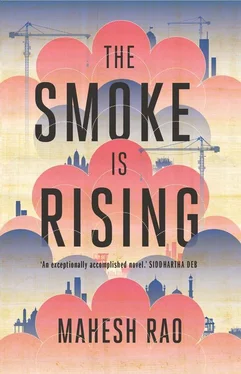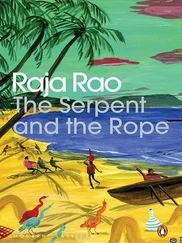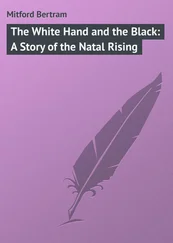Shankar jumped back into the water, turned around and shrugged.
‘The water’s still coming in but it’s better. We’ll see. Come on, let’s go.’
‘But where?’ she asked.
‘It’s too far to go to Janaki’s mother’s house in this rain. We’ll go to my house and then I’ll take you to Janaki when the rain stops.’
Uma had no desire to go anywhere. She felt like a creature thrown up by the deluge who bore a natural obligation to witness the waters recede. But she also lacked the energy to protest. She slowly lowered her legs into the water, still clasping the picture of Shiva with one arm. Shankar did not offer her his hand. She followed him towards the doorway, taking tiny steps through the turbid pool, as if her feet had been manacled. Shankar waited for her to reach the row outside, his eyes avoiding her face.
‘I’ll try and close the door and then we can go,’ he said.
He tried to pull the door shut with all the strength he could muster but it would not budge against the heft of the water.
‘There’s no money or jewellery in there?’ he asked.
Uma shook her head.
‘Then let’s leave it and go.’
They worked their way through the flood to the edge of the surrounding slope and then laboriously climbed up to the main road, their feet disappearing into the greedy mire. Every now and then Shankar would turn around to glance down at Uma, catching sight of her outstretched arm as she tried to tramp up the incline without sliding into its swampy creases.
The tides of water continued to drum down. Shankar wiped the mud off his feet on a concrete slab by the edge of the road, slipped his chappals on and started the motorbike.
‘Why are you standing there? Come on,’ he called.
Uma hesitated and then shuffled forward. She sat down behind him, her ankles pressed together in a tense bind, her left hand grasping the rear grab rail, trying to maximise the distance between them. Her other arm pinned the picture of Shiva to her chest.
‘Ready?’ he asked.
‘Yes,’ she said, feeling like her legs would abandon her, founder and collapse onto the ground.
Shankar eased the bike through the overflowing ruts, blinking hard to keep the water out of his eyes. The road was deserted as they rode slowly towards the open fields that bordered the highway, the wheels hissing against the wet tarmac. Uma glanced down at the back of the picture of Shiva, now streaked with a web of fuzzy lines. Shankar’s back was perfectly straight and his shoulders tight with an inescapable awareness. Six inches of water and wind separated him from Uma and in that space there began to fan out the torturous wings of a new certainty. They brushed against Shankar’s vertebrae and paused over the nape of his neck. Uma felt them beat a hot gust against her ribs and cast a shadow over her face. The gap between them was not large but it was enough to accommodate the flailing realisation that, as they headed to Shankar’s home in the rain, they would not make it any further that night.
THE law courts of Mysore were housed in an Indo-Saracenic nugget opposite the faded green of Manuvana Park. The building had gained national prominence when a scene from a super-hit film song of the seventies had been filmed on its front lawn, between rows of flame-hued zinnias. These days the garden was bedraggled and contrite, its flower beds plagued by stray dogs who would collapse in the scanty shade of the frangipani trees like a set of errant commas. Justice, as envisioned by a Scottish sculptor in 1908, sat heavily on a plinth in the court complex. The downturned sword in her right hand looked like a walking aid and the expression on her face appeared to suggest immense relief at having been able to take the weight off her feet. If the artist had intended to create an impression of stately reason, safeguarding truth with a powerful gaze, his facility had failed him. In Mysore, justice took on the guise of an irritated matron who really did not wish to be harangued by the petty squabbles of an ungrateful rabble.
Behind the court car park, a number of shed-like structures housed the more prominent of the city’s tireless notaries. This was a prime location: some family feuds over the deserving occupant of a notarial seat here had spilled across generations. The longest serving functionary in this cloister was I P K Rangaraja, a man famed for his probity and his devotion to an ancient tweed suit, worn as a mark of contempt for the Mysore weather. Some years ago he had famously uncovered the participation of a number of his colleagues in a scam involving the submission of falsified land title documents. The unscrupulous notaries were soon attending court in a different capacity and Mr Rangaraja basked in the exaltation that came with successfully guarding a profession from disrepute.
Opposite the seat of the notaries’ operations, the shade of a large sampige tree acted as a billet for the squadrons of interested parties that gravitated towards any hub concerned with the dispensation of justice. Scribes carrying portable typewriters zealously guarded space on the wooden benches. Ambulance chasers mingled with hotel touts; students at the evening law college shared experiences with sympathetic conmen; journalists killed time by trying to tease out scandals from desperate petitioners. The vexatious litigants could always be identified by their plastic bags full of papers and the lust for substantive advantage that warped their backs.
One gentleman with close-cropped, greying hair in a crisp white kurta was a steadfast feature of this juridical bazaar. He arrived on foot every weekday morning at exactly ten o’clock, in his hands a thick folder and a basket containing his lunch dabba . His exemplary attendance meant that the scribes even offered him a place on one of the benches. The man spent his time looking through his papers and benignly taking in the day’s events. He never solicited conversation but always responded to questions politely, neither enlightening nor offending anyone.
In the past few weeks, security at the court building had been increased, not as a result of threats from terrorists or organised criminals, but due to the increasingly animated conduct of the members of the Mysore Law Congress. The genesis of the strife could be traced back to an incident six months ago when an advocate’s motorbike rammed into the back of a judge’s car outside the court. There were no casualties but a frenzied row had ensued with the use of vivid language on both sides. Official complaints were made, investigations pursued and the matter would have ended, reaching some forgettable stalemate, were it not for the fact that elections to the post of President of the Mysore Law Congress were imminent. The two main candidates, not confident that caste affiliations and their own distinguished professional histories would deliver victory, had dredged up the incident as a symbol of the disharmony that could disable the Congress’s future activities, without strong and dynamic leadership. A bilious brew of local gossip, procedural irregularities, vested interests, caste politics and tutored braggadocio meant that a strike of local lawyers was virtually inevitable. The Mysore Evening Sentinel called it an unforgivable perfidy that struck at the heart of the administration of justice. To the congregation under the sampige tree, it was simply another inconsequential distraction.
Beyond the parochial concerns of the courts in Mysore, the broader legal community was involved in an intense debate that now engaged many sections of civil society. The subject of the controversy was proposed legislation that could make the declaration of judicial assets mandatory and subject to public scrutiny. The majority of judges, of course, were entirely content that details of their wealth be submitted to the appropriate authorities. In fact, many of them were already providing this information to various bodies who could be trusted to treat it with responsibility and respect.
Читать дальше












